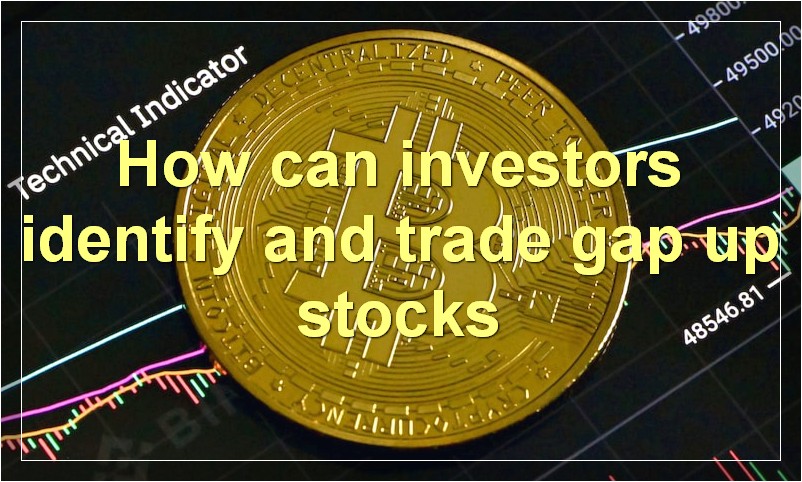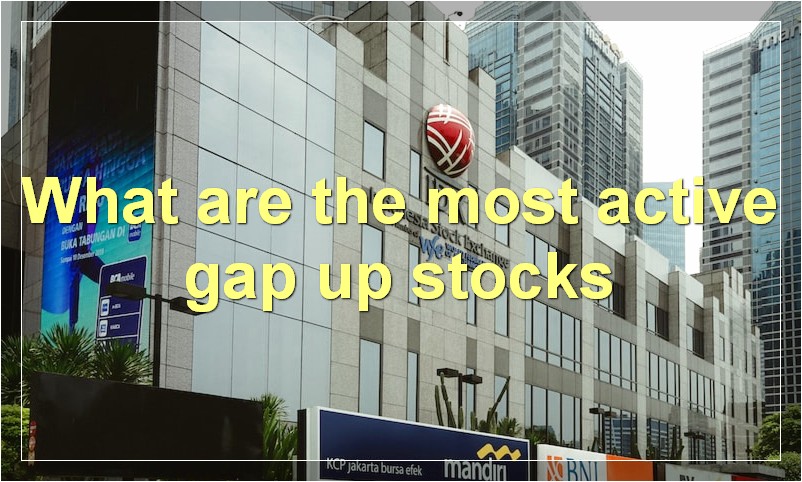If you’re looking to get ahead in the stock market, it’s important to understand what causes prices to gap up. Gaps can provide important clues about the underlying health of a company and the market’s perception of it. While there are many reasons why prices might gap up, here are three of the most common causes.
What are the most common causes of a gap up in stock prices
When it comes to trading stocks, a gap up occurs when the price of a security opens at a higher price than it closed at the previous day. While there can be a number of reasons for this to happen, there are five common causes that tend to lead to a gap up in stock prices.
1. Positive Earnings Surprise: One of the most common reasons for a gap up is when a company reports earnings that are better than what analysts were expecting. This positive surprise can lead to an influx of buying activity as investors look to get in on a company that is doing better than expected.
2. Improved Guidance: Another reason that can lead to a gap up is when a company raises its guidance for the future. This could be due to a number of factors such as an improvement in the overall economy or the company’s own business prospects. Either way, this news is generally well received by the market and can lead to a gap up.
3. Analyst Upgrade: Sometimes a company’s stock price will gap up after an analyst upgrades their rating on the stock. This could be due to the analyst having revised their estimates for the company’s earnings or some other positive development. In any case, an analyst upgrade can be seen as a vote of confidence in a stock and lead to some buying activity.
4. M&A Activity: Another potential reason for a gap up is when there is news of merger or acquisition activity involving the company. This could be either rumors or actual announcements, but either way, it generally leads to increased interest in the stock and can cause prices to gap up.
5. Positive News: Finally, sometimes a company will just have some positive news that leads to a gap up in its stock price. This could be anything from winning a major contract to developing a new product that is getting buzz. Whatever the case may be, positive news can often lead to a gap up.
How can investors identify and trade gap up stocks

If you’re looking for stocks that are likely to gap up, there are a few things you can look for. First, look for stocks that have been trending up over a period of time. This indicates that there is strong demand for the stock. Second, look for stocks that have had recent news that is positive and could trigger more buying. Finally, look for stocks that have low levels of supply and high levels of demand. This can be indicated by high levels of short interest or large amounts of insider buying.
What are the risks associated with gap up stocks
When a stock “gaps up,” it means that the stock price opens at a higher level than the previous day’s close. This usually happens when there is some news that has investors excited about the stock. For example, if a company announces a new product that is going to be a big hit, you might see the stock gap up the next day.
While gaps can be caused by good news, they can also be caused by bad news. If a company misses its earnings estimates, for example, you might see the stock gap down the next day. So, while gaps can provide an opportunity to make some quick profits, they can also be very risky.
Here are a few things to keep in mind if you’re thinking about trading gap stocks:
1. Be sure to do your research. When a stock gaps up or down, it’s important to know why. Is it due to positive news, or is it because of something negative? If you don’t know the reason for the gap, you could end up losing money.
2. Be prepared for volatility. Stocks that gap up (or down) are often more volatile than other stocks. This means that they can move up and down quickly, and it can be difficult to predict which way they will go. If you’re not comfortable with volatility, gap stocks may not be right for you.
3. Have a plan. Before you buy any stock, you should have a plan for how you’re going to trade it. This is especially true for gap stocks. You need to know how much risk you’re willing to take and have a plan for taking profits (or cutting losses) if the stock moves against you.
What are the best strategies for trading gap up stocks
There are a few things to consider when trading stocks that have gapped up:
-The reason for the gap: Is it due to positive news or earnings? If so, the stock may have more room to run. If not, the gap may be due to a short squeeze and the stock may be overbought.
-The price action: Is the stock gapping up on strong volume? If so, this may be a bullish sign. If the gap is on light volume, it may be a false move and the stock could quickly reverse.
-The level of resistance: If the stock is gapping up into a area of previous resistance, it may be difficult for the stock to continue higher. If the gap is above previous resistance, the stock may have more upside potential.
-Your own risk tolerance: Always use stop losses when trading stocks, but especially when trading stocks that have gapped up. These stocks can be volatile and you don’t want to get caught in a big loss.
What are the most volatile gap up stocks
The most volatile gap up stocks are those that have the greatest price movement during the day. This can be caused by a number of factors, including news events, earnings releases, and analyst upgrades or downgrades.
What are the most active gap up stocks

Gap up stocks are stocks that open at a higher price than they closed at the previous day. These stocks are often seen as a sign of strength in the market, and they can be a great way to make money if you know how to trade them correctly.
There are a few things you need to look for when finding gap up stocks. First, you want to find stocks that have strong fundamentals. This means that the company is doing well and is expected to continue doing well in the future. Second, you want to find stocks that have a lot of volume. This is important because it means that there is a lot of interest in the stock and that it is more likely to move in the direction you want it to. Finally, you want to find stocks that are trading at a discount to their intrinsic value. This means that they are undervalued by the market and have the potential to go up in value in the future.
If you can find stocks that meet all of these criteria, then you have a good chance of making money on them. However, it is still important to do your own research before investing.
What are the best performing gap up stocks
Gap up stocks are those that rise in price after opening higher than the previous day’s close. While there are many factors that can contribute to a stock’s performance, gap ups often indicate that there is strong buying demand for the stock.
There are a number of ways to identify gap up stocks. One method is to scan the market for stocks that have opened at least 5% above the previous day’s close. Another way is to look for stocks that have gapped up on heavy volume. This can be an indication that institutional investors are buying the stock.
Once you have identified a few gap up stocks, it is important to do your own research to determine if the stock is a good investment. Some things you may want to consider are the company’s financial stability, recent news, and analyst ratings.
If you find a gap up stock that looks like a good investment, don’t be afraid to take advantage of the opportunity. These stocks often move quickly and can provide some nice profits.
What are the worst performing gap up stocks
Gap up stocks are those that open higher than they closed the previous day. While this might seem like a good thing, it’s actually one of the worst performing types of stocks. This is because investors tend to buy into the hype and push the prices up too high, too fast. When the stock eventually corrects, it can fall hard and fast, leading to big losses for investors.
Are there any seasonal patterns in gap ups stocks
There are definitely seasonal patterns in gap up stocks! For example, many stocks tend to gap up in the springtime as the weather gets warmer and people start to feel more optimistic about the future. Additionally, many stocks also tend to gap up around the holidays as people are buying gifts and generally feeling more festive.
What news events tend to cause gap ups in stock prices
There are a few different types of news events that tend to result in positive price movement, or “gap ups,” for stocks. One is when a company announces positive earnings results that exceed analyst expectations. This can be a signal that the company is doing better than previously thought and may continue to outperform in the future. Another type of event that can cause a gap up is an analyst upgrading their rating or price target for a stock. This means that the analyst believes the stock is undervalued and has upside potential. Finally, M&A activity can also lead to gap ups, as investors bet on the potential synergies between the two companies involved.

